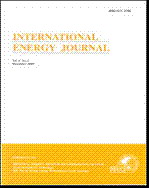ThaiScience
ThaiScience
INTERNATIONAL ENERGY JOURNAL
Volume 22, No. 03, Month SEPTEMBER, Year 2022, Pages 255 - 268
Techno-economics assessment of geothermal binary cycle power plant located in isolated grid
Suardi Nur, M. Faisi Ikhwali, Nur Aida
Abstract Download PDF
Jaboi geothermal project experiences a long delay since its concession winning bidder declared in 2008. Based on the latest study, Jaboi geothermal resource can produce up to 40 MW electricity. However, resource location in an isolated grid island that has limited electricity demand is the constraint for its development. In the current study, we propose a conceptual design of a geothermal power plant adapted the load profile in an isolated electricity grid such as in Sabang City, Weh Island, in Indonesia. The electricity generated in the island is not able to be transmitted to the main island of Sumatra. Therefore, to be viable the power plant must be designed to follow the demand existed on the island. To design a demand-based power plant, we perform a thermodynamic analysis of a geothermal binary cycle by using Engineering Equation Solver (EES) software. The optimal flow rate of geothermal fluid required to meet the demand is determined. The simulation results reveal that to produce a 3 MW net power output geothermal binary power plant, it requires a total of 95 kg/s geothermal fluid mass flow rate. Theoretically, this mass flow rate can be supplied from one production well. Therefore, a well-doublet system consisting of a production and re-injection wells can be deployed as the most economic option.
Keywords
Binary cycle power plant; EES simulation; Geothermal energy; Techno-economic assessment; Thermodynamic modelingINTERNATIONAL ENERGY JOURNAL
Published by : Asian Institute of Technology
Contributions welcome at : http://www.rericjournal.ait.ac.th
